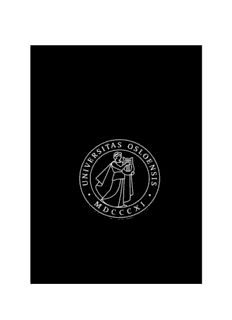
Furu-2017 PDF
Preview Furu-2017
Profitable Altruism The impact of microfinance in improving livelihoods in Kenya Sofie Shirin Erna Furu Spring 2017 Master’s thesis at the Institute for Political Science UNIVERSITY OF OSLO Word Count: 37 300 Profitable Altruism The impact of microfinance in improving livelihoods in Kenya ii Copyright Forfatter: Sofie Shirin Erna Furu År: 2017 Tittel: Profitable Altruism Forfatter: Sofie Shirin Erna Furu http://www.duo.uio.no Trykk: Reprosentralen, Universitetet i Oslo iii iv Summary Microfinance has been recognized globally as a strategy in alleviating poverty and empowering women. However, developing countries government cannot solve these issues alone due to financial implications, and global development aid is decreasing. This has in turn necessitated the private sector and non-governmental organizations to intervene in the market, and find innovative ways in tackling poverty in Kenya. Microfinance programs have been introduced to provide financial services to the remote, low-income earners, focusing on women, which has been found to be effective in reducing poverty, creating employment and empowering women. This dissertation will assess to what extent microfinance has an impact on women’s livelihood in Kenya. In order to answer this, it employs human- and social capital theory to evaluate the Kenyan microfinance bank, Kenya Women Finance Trust Limited’s (KWFT), impact on clients’ livelihood. Further, the microfinance institution has for the past decade gone through a transformation from a non-profit to a full-fledged commercial microfinance bank. Primary data was collected from 49 informants in Kenya and Norway, and tabular and graphical methods have been supplemented to analyze data. The study, based on the results on livelihood, assess the theoretical critique on commercialization, and demonstrate how commercialization affects outreach in for-profit microfinance institutions. Further, it analyses the relationship between the Norwegian public/private initiative Nordic Microfinance Initiative (NMI) who invests in KWFT, and determine how the investment affect outreach in Kenya, and whether NMI follow their stated mission in prioritizing the social mission over financial profits. Based on this result I conclude that the investments have a positive impact on poverty alleviation, employment and empowerment among poor women in Kenya, with certain limitations and opportunity for increased supervision. v vi Acknowledgments This dissertation would not have been realized without the help and motivation of several people. It has been an extraordinary learning curve, starting with marginal knowledge of the field, to an immense interest and experience. I would like to pay special tribute to Samantha and Daniel for hosting me during my fieldwork in Kenya, and helping me from the smallest bits of settling in to introducing me to a handful of people within the microfinance sector. My dissertation would not have been what it is today without your assistance. You helped me in a moment of helplessness, and provided me with a foot in the door in a country I had no previous network or knowledge of, all out of complete selflessness, which I am extremely grateful of. I further want to use this opportunity to thank everyone else who out of pure kindness helped me, both with fieldwork related issues and not, in Kenya, making it a memory of a lifetime. My gratitude also goes to all my informants taking time out of their day to see me, and putting me in contact with other informants. I am also extremely grateful of my supervisor Dan Banik, for always motivating and supporting me. Your passion for your field is tremendously motivating, and throughout the whole period I have found your help, ambition and support a strong motivation to work hard. Your continual help and effort has throughout the year strengthened my interest for the field, and my final result would not be the same without your help. Finally, I would like to thank friends and family for constant support and motivation, and especially new friends made in Kenya, who through poignant and stimulating conversations have inspired me to widen my horizon. vii ”Poverty must be seen as the deprivation of basic capabilities rather than merely as low incomes” Amartya Sen viii Abbreviations MFI: Microfinance institution KWFT: Kenya Women Finance Trust Limited NMI: Nordic Microfinance Initiative SHGs: Self-help groups SLGs: Savings- and loan groups ROSCA: Rotating savings and credit associations ASCA: Accumulating savings and credit associations NGO: Non-governmental organization NBIF: Non-bank financial institution IFI: International financial institution WB: World Bank UN: United Nations GDP: Gross domestic product OECD: Organization for Economic Co-operation and Development DTM: Deposit taking microfinance ix Content CHAPTER 1 INTRODUCTION ........................................................................................... 1 1.1 RESEARCH QUESTION ..................................................................................................... 3 1.2 CHOICE OF STUDY ........................................................................................................... 3 1.3 METHODOLOGY ............................................................................................................... 5 1.3.1 Epistemology ............................................................................................................ 5 1.3.2 Ontology ................................................................................................................... 6 1.4 DATA COLLECTION METHODS ....................................................................................... 10 1.5 PRIMARY DATA .............................................................................................................. 11 1.6 TIME HORIZON AND FIELDWORK .................................................................................. 13 1.6.1 Individual interviews .............................................................................................. 14 1.6.2 Focus groups .......................................................................................................... 14 1.7 ETHICS ........................................................................................................................... 15 1.8 SECONDARY DATA ......................................................................................................... 15 1.9 METHODOLOGICAL CHALLENGES ................................................................................ 16 1.10 RELIABILITY, VALIDITY, AND GENERALIZATION OF THE STUDY ............................... 18 1.11 THESIS OUTLINE .......................................................................................................... 19 CHAPTER 2 THEORETICAL PERSPECTIVES ............................................................ 21 2.1 MICROFINANCE ............................................................................................................. 22 2.1.1 The Grameen Approach......................................................................................... 24 2.1.2 Financial inclusion ................................................................................................ 25 2.2 TYPES OF MICROFINANCE INSTITUTIONS ...................................................................... 27 2.2.1 Informal microfinance providers .......................................................................... 27 2.2.2 Membership-based organizations .......................................................................... 28 2.2.3 Non-governmental organizations .......................................................................... 29 2.2.4 Formal microfinance institutions .......................................................................... 29 2.3 FUNDING ........................................................................................................................ 31 2.3.1 International donors .............................................................................................. 33 2.3.2 International investors ........................................................................................... 34 2.3.3 Domestic funding markets ..................................................................................... 34 2.4 MICROFINANCE IMPACTS .............................................................................................. 34 2.5 HOW CAN THE IMPACT OF MICROFINANCE BE MEASURED? ......................................... 35 2.5.1 Human capital ........................................................................................................ 36 2.5.2 Social capital .......................................................................................................... 37 2.6 EMPOWERMENT OF WOMEN ......................................................................................... 40 2.7 MAIN APPROACHES TO MICROFINANCE ........................................................................ 41 2.7.1 The welfarist approach .......................................................................................... 42 2.7.2 Institutional approach ........................................................................................... 43 2.8 PARADIGM SHIFT ........................................................................................................... 45 2.9 CRITIQUE OF MICROFINANCE ....................................................................................... 48 2.10 OPERATIONALIZATION ................................................................................................ 50 CHAPTER 3 MICROFINANCE IN KENYA .................................................................... 52 x
Description: